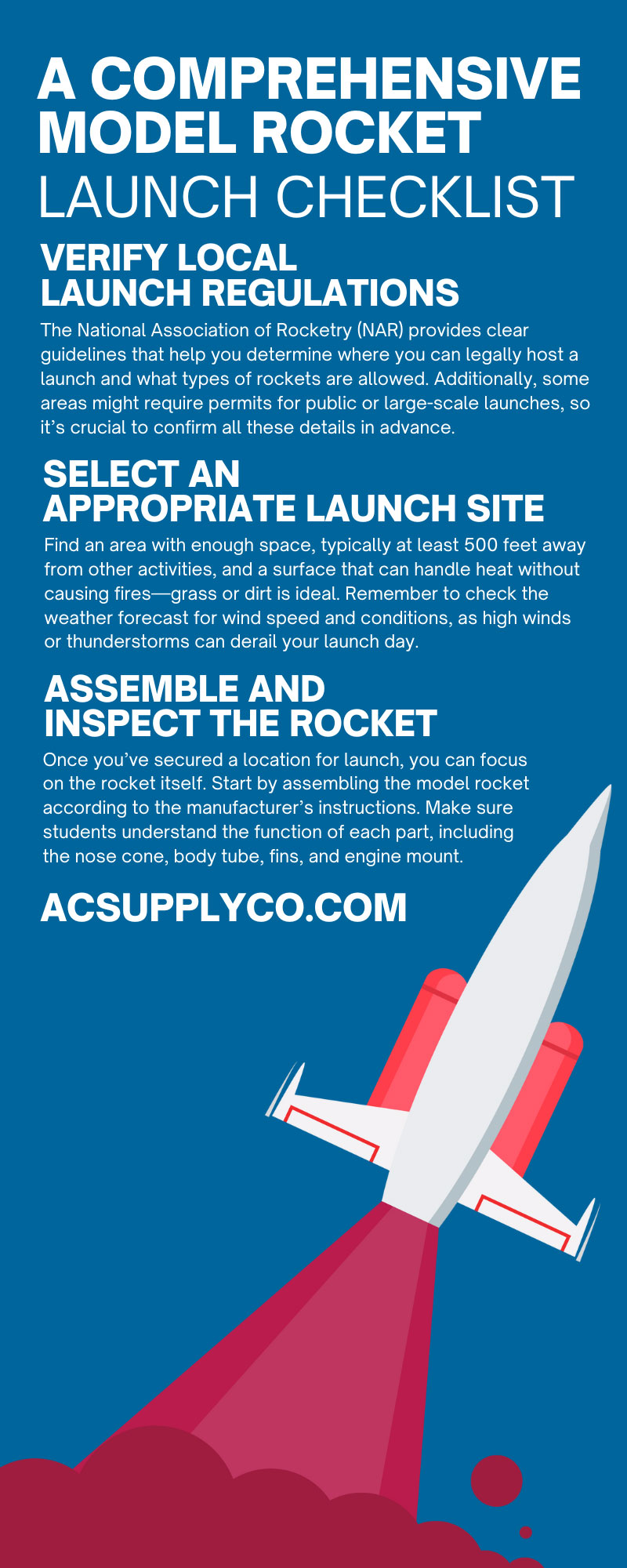Launching a model rocket is one of the most exciting hands-on educational experiences you can offer students. Your students get to learn about important science principles while laying the groundwork for a safe and successful launch.
Whether you’re organizing a small classroom event or a large-scale science project, following a thorough checklist will keep the process smooth and safe. Use our comprehensive model rocket launch checklist to guide you through every step of this educational journey. With our help, you will have the knowledge to manage your students and equipment with confidence.
Verify Local Launch Regulations
Before launching your rocket, you must confirm that your project complies with all applicable local regulations. Some areas may have restrictions regarding model rocket launching, and you’ll want to remain compliant with federal, state, and local laws.
The National Association of Rocketry (NAR) provides clear guidelines that help you determine where you can legally host a launch and what types of rockets are allowed. Additionally, some areas might require permits for public or large-scale launches, so it’s crucial to confirm all these details in advance.
Select an Appropriate Launch Site
Choosing the right launch site is a critical step. Ideally, you’ll want a large, open area free from obstructions like trees, buildings, and power lines. Parks, school fields, or specialized rocket launch fields work well for educational purposes.
Find an area with enough space, typically at least 500 feet away from other activities, and a surface that can handle heat without causing fires—grass or dirt is ideal. Remember to check the weather forecast for wind speed and conditions, as high winds or thunderstorms can derail your launch day.
Assemble and Inspect the Rocket
Once you’ve secured a location for launch, you can focus on the rocket itself. Start by assembling the model rocket according to the manufacturer’s instructions. Make sure students understand the function of each part, including the nose cone, body tube, fins, and engine mount.
After assembly, inspect the rocket carefully. Look for any loose parts or misalignments that could cause a failure during the launch. Additionally, determine whether the fins are securely attached, as they’re essential for flight stability.
Choose the Correct Rocket Engine
Selecting the right rocket engine is crucial for a safe and successful flight. Model rocket engines come in different sizes and thrust capacities, and choosing the wrong one could lead to an unstable or failed flight.
Engines are typically labeled with a letter and number code that indicates their total impulse and burn time. Beginners should stick to lower-power engines like A or B, while more experienced students can experiment with higher-power engines. You’ll also want to match the engine to the weight and size of the rocket for optimal performance.
Prepare the Recovery System
The recovery system helps your rocket return safely to the ground. Most model rockets use parachutes or streamers that deploy after the engine cuts off, reducing the rocket’s speed and allowing for a soft landing.
Before launching the rocket, properly pack the recovery system into the rocket body. It’s important to fold the parachute or streamer correctly and secure it with wadding to protect it from the engine’s ejection charge. You can test the deployment system by gently pulling on the recovery line to verify that it’s not tangled or obstructed.
Set Up the Launch Pad and Controller
You must have a stable, secure launch pad to achieve smooth liftoff. Follow the manufacturer’s instructions when setting up the launch pad, and double-check that it’s level and anchored to the ground.
Place the rocket onto the launch rod, keeping it aligned properly. You should also place the launch controller, which ignites the rocket engine, at a safe distance from the pad.
Test the controller’s connections and batteries to make sure everything works before you have the students gather for the launch. Make sure your students follow all safety protocols, like standing at least 15 feet away from the launch pad during ignition.
Conduct a Pre-Launch Safety Check
Safety is paramount when launching model rockets, especially in an educational setting. Before launching, conduct a final safety check. Verify that all students and spectators are at a secure distance before reviewing the launch procedure.
Everyone involved in the launch should know the countdown process and what to do in case of an emergency. You should also remind students about the importance of never approaching the launch pad after the countdown has started, even if the rocket fails to launch initially.
Perform a Final Countdown and Launch
With everything set up and safety checks complete, it’s time for the final countdown. Have students join in, as this activity builds anticipation and makes the experience more interactive.
A standard countdown usually starts at five and upon reaching zero, the activated controller ignites the rocket engine. This part of the launch is the moment of truth—if you’ve done your job well, you’ll watch the rocket shoot into the sky, deploy its recovery system, and gently float back to Earth.
Retrieve and Inspect the Rocket Post-Launch
After the rocket lands, it’s important to inspect it thoroughly. Use this as a learning opportunity for students to evaluate how well the rocket performed. Did the parachute deploy correctly? Did the rocket follow the ideal trajectory?
Look for any damage or wear on the body tube, fins, and engine mount. Discuss the results with your students, noting any possible improvements for future launches. You might be able to attempt another launch depending on the rocket’s condition.
Clean Up the Launch Area
Finally, you should clean up the launch site and leave it the way you found it. It’s important for you to teach students to respect their surroundings, especially when engaging in outdoor activities.
Collect any debris, like used engines, launch pads, or wadding, and dispose of these items properly. This step keeps the launch site available for future use and leaves a positive impact on the environment.
AC Supply: Your Gateway to an Exciting Educational Experience
Working with your students to launch a model rocket is a thrilling and educational experience that requires thorough planning and preparation. Following a comprehensive model rocket launch checklist will help you cover all the necessary safety protocols and equipment checks, making the day enjoyable for you and your students.
From verifying local regulations to performing post-launch inspections, each step is crucial to a successful launch. As you continue to guide your students through model rocket projects, remember that understanding each component, from the recovery systems to the model rocket engines, helps foster a deeper appreciation for science and engineering.
We encourage you to search our website to find fun educational tools that will inspire your students to engage with STEM subjects. AC Supply sells model rocket kits that are suitable for all ages and educational backgrounds. With our help, you can build a model rocket with your students and watch their faces light up as they witness firsthand the power of physics and engineering principles.



